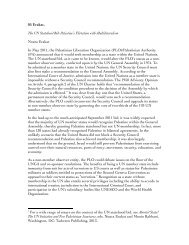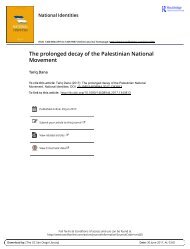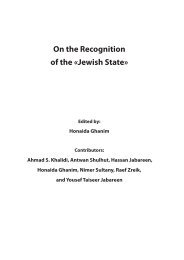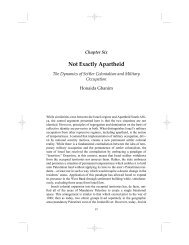The Kanafani Effect: Resistance and Counter-Narration in the Films of Michel Khleifi and Elia Suleiman
Guided by Ghassan Kanafani’s seminal studies on ‘resistance literature’, this paper extends the concept to contemporary Palestinian fiction film to explore its permuta- tions in the visual medium. - By Refqa Abu-Remaileh
Guided by Ghassan Kanafani’s seminal studies on ‘resistance literature’, this paper extends the concept to contemporary Palestinian fiction film to explore its permuta- tions in the visual medium. - By Refqa Abu-Remaileh
Create successful ePaper yourself
Turn your PDF publications into a flip-book with our unique Google optimized e-Paper software.
198 abu-remaileh<br />
a script he had begun while <strong>in</strong> New York, <strong>and</strong> which eventually became his<br />
first feature film, Chronicle <strong>of</strong> a Disappearance. <strong>The</strong> result was a m<strong>in</strong>imalist<br />
diary-like narrative where<strong>in</strong> scenes <strong>of</strong> an episodic nature <strong>of</strong>fered an unconventional<br />
treatment <strong>of</strong> <strong>the</strong> Palest<strong>in</strong>ian ideal <strong>of</strong> return. Indeed, <strong>Suleiman</strong> himself<br />
had returned to a situation that had changed remarkably s<strong>in</strong>ce <strong>Khleifi</strong>’s Wedd<strong>in</strong>g<br />
<strong>in</strong> Galilee. <strong>The</strong> <strong>in</strong>tegral relationship <strong>Kanafani</strong> had seen exist<strong>in</strong>g between<br />
culture <strong>and</strong> armed resistance had subsided significantly s<strong>in</strong>ce <strong>the</strong> Palest<strong>in</strong>ian<br />
leadership had been forced <strong>in</strong>to a fur<strong>the</strong>r exile <strong>in</strong> North Africa <strong>in</strong> 1982. <strong>The</strong>reafter,<br />
<strong>the</strong> locus <strong>of</strong> political activity had gradually shifted to <strong>the</strong> West Bank <strong>and</strong><br />
Gaza Strip, where grassroots resistance ga<strong>the</strong>red momentum throughout <strong>the</strong><br />
1980s before culm<strong>in</strong>at<strong>in</strong>g <strong>in</strong> <strong>the</strong> mass upris<strong>in</strong>gs that became known as <strong>the</strong> First<br />
Intifada, erupt<strong>in</strong>g <strong>in</strong> 1987—not long after <strong>the</strong> release <strong>of</strong> Wedd<strong>in</strong>g <strong>in</strong> Galilee.<br />
<strong>The</strong> Intifada catapulted <strong>the</strong> Palest<strong>in</strong>ian struggle under occupation <strong>in</strong>to public<br />
consciousness, <strong>and</strong> eventually forced <strong>the</strong> <strong>in</strong>ternational community to <strong>in</strong>tervene<br />
<strong>in</strong> a bid to lessen <strong>the</strong> violence. <strong>The</strong> results <strong>of</strong> <strong>the</strong>se <strong>in</strong>terventions became<br />
known as <strong>the</strong> ‘Oslo peace process’, tak<strong>in</strong>g <strong>the</strong>ir name from <strong>the</strong> <strong>in</strong>terim agreement<br />
signed <strong>in</strong> 1993 by plo Chairman Yasser Arafat <strong>and</strong> Israeli Prime M<strong>in</strong>ister<br />
Yitzhak Rab<strong>in</strong>; this established direct negotiations between <strong>the</strong> two parties <strong>and</strong><br />
proposed lend<strong>in</strong>g a form <strong>of</strong> limited self-government to a transitional body, <strong>the</strong><br />
so-called Palest<strong>in</strong>ian Authority (pa). <strong>The</strong> pa essentially assumed jo<strong>in</strong>t responsibility<br />
with Israel for polic<strong>in</strong>g its own people, <strong>in</strong> exchange for questionable<br />
promises <strong>of</strong> partial Israeli withdrawals from limited areas <strong>of</strong> <strong>the</strong> West Bank<br />
<strong>and</strong> Gaza Strip. Oslo thus signaled a counter-revolutionary turn, marked by<br />
a bureaucratization <strong>of</strong> <strong>the</strong> national movement. It became <strong>in</strong>tensely divisive<br />
among Palest<strong>in</strong>ians, with many notable public figures outspokenly criticiz<strong>in</strong>g<br />
<strong>the</strong> shift, <strong>in</strong>clud<strong>in</strong>g Mahmoud Darwish <strong>and</strong> Edward Said. More militant critical<br />
opponents later launched a new phase <strong>of</strong> armed struggle, some <strong>of</strong> <strong>the</strong>m<br />
embark<strong>in</strong>g on a campaign <strong>of</strong> suicide bomb<strong>in</strong>gs.<br />
This was <strong>the</strong> fraught <strong>and</strong> divisive scene that <strong>Suleiman</strong> entered when he<br />
returned to <strong>the</strong> homel<strong>and</strong>. Be<strong>in</strong>g critical <strong>of</strong> <strong>the</strong> new political project himself,<br />
he quickly realized that <strong>the</strong> vacuum created by <strong>the</strong> demise <strong>of</strong> all-encompass<strong>in</strong>g<br />
political ideologies had <strong>in</strong>advertently opened up new spaces for cultural <strong>and</strong><br />
creative dissent. In an understated but critical manner, <strong>Suleiman</strong>’s Chronicle <strong>of</strong><br />
a Disappearance records <strong>the</strong> disillusionment that followed <strong>the</strong> Oslo agreement,<br />
mak<strong>in</strong>g a series <strong>of</strong> satirical image-comments on <strong>the</strong> alleged hollowness <strong>of</strong> its<br />
new bureaucratic façade. Address<strong>in</strong>g <strong>the</strong> reduction <strong>and</strong> fragmentation <strong>of</strong> Palest<strong>in</strong>ian<br />
l<strong>and</strong>s as a result <strong>of</strong> <strong>the</strong> Oslo process, <strong>and</strong> highlight<strong>in</strong>g <strong>the</strong> many unfulfilled<br />
promises that process <strong>in</strong>volved, Chronicle <strong>of</strong> a Disappearance <strong>in</strong>troduces<br />
a powerful element <strong>of</strong> Palest<strong>in</strong>ian self-critique with its sardonic depiction <strong>of</strong><br />
<strong>the</strong> results <strong>of</strong> <strong>the</strong> <strong>in</strong>terim agreement. At one po<strong>in</strong>t we encounter es, Sueliman’s<br />
Middle East Journal <strong>of</strong> Culture <strong>and</strong> Communication 7 (2014) 190–206








